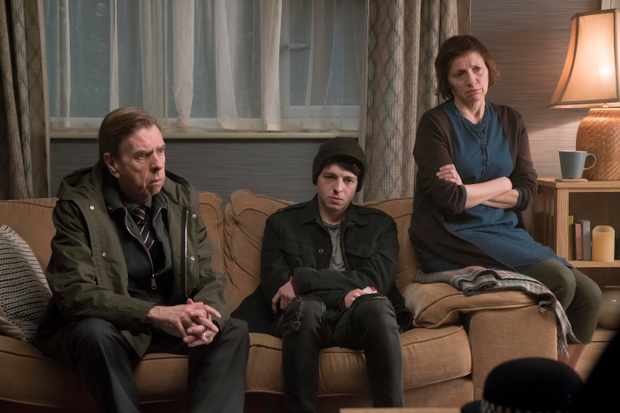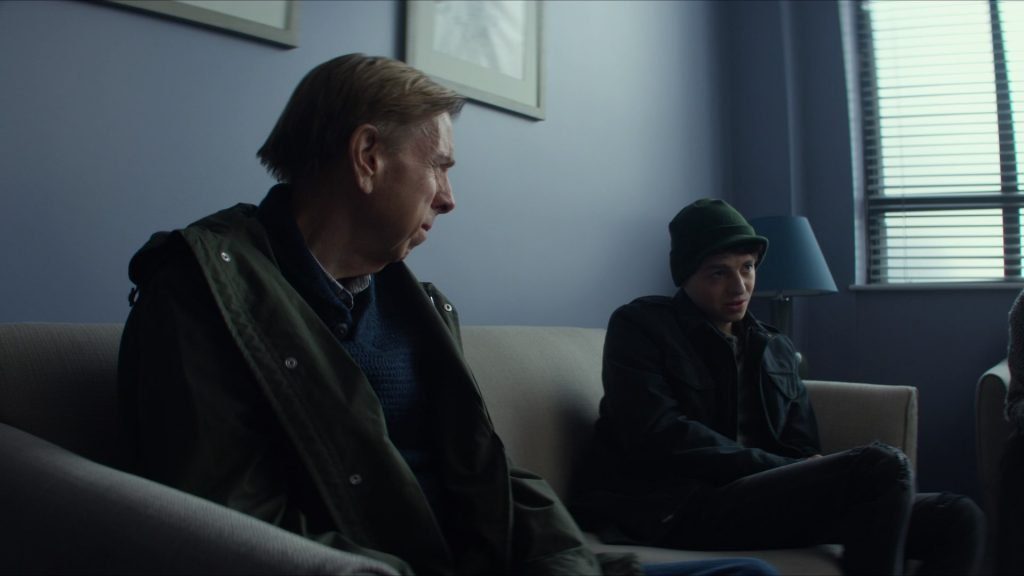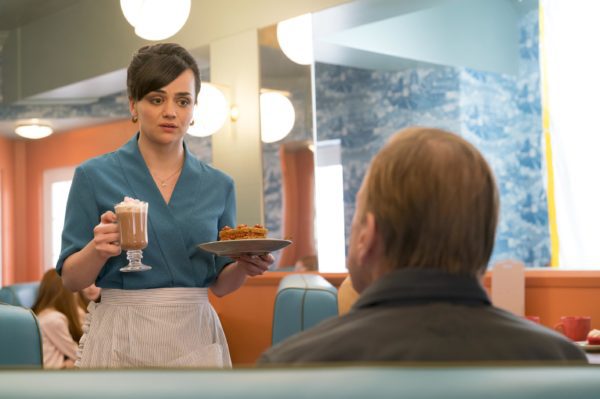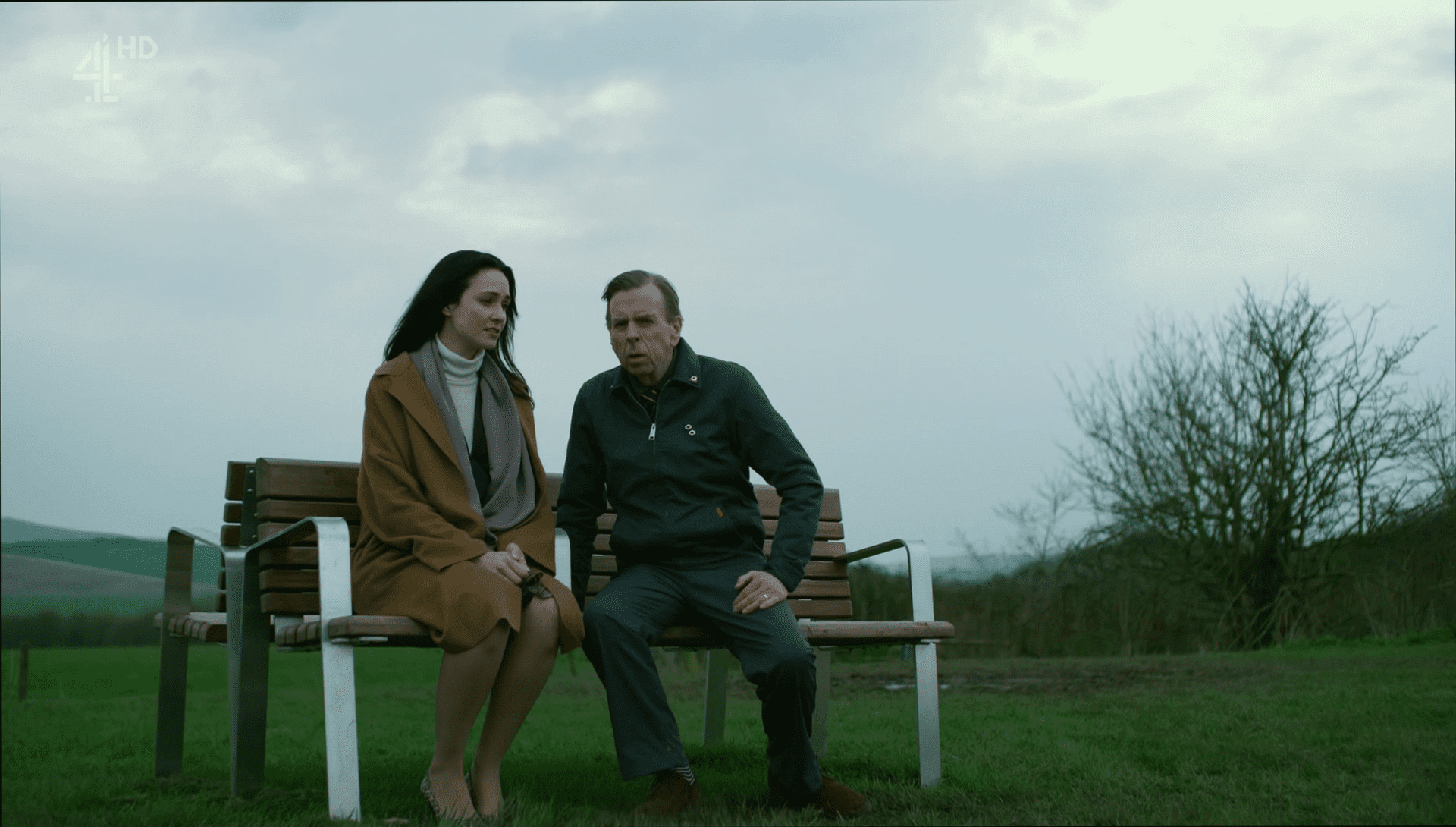The kind of long narrative of serialized TV can be wonderfully immersive, but here at 25YL we also recognize the value of a great standalone episode. Join us as we explore horror and sci-fi anthologies old and new, along with some other standout episodes of shows you love. This week, Chris Flackett examines an episode of Philip K. Dick’s Electric Dreams.
Just being alive, it can really hurt
And these moments given are a gift from time
Just let us try to give these moments back
To those we love,to those who will survive
Full disclosure: I wasn’t the biggest fan of Philip K. Dick’s Electric Dreams. Visually sumptuous, it built living, breathing worlds to wrap around its adaptions of ten different Dick short stories, but then forgot to allow the plots to breathe too, to develop organically. This is shocking when you consider the quality of the source material. These wonderful, humanist tales of people battling against assumptions about reality and about themselves are flattened by the storytelling in every case…
With one exception.
“The Commuter” is a sparse, quiet meditation on trauma, love and the tricks the mind can play on itself in order to function in the face of despair. It asks whether it is better to escape your pain, if escaping is even possible, or if it is better to face your pain head on, no matter the end result.
Ed Jacobson, played empathetically by the great Timothy Spall, is getting it in the neck from all angles; working at Woking train station, a customer blocks a toilet without apology for Ed to unblock; a woman abuses him for a lack of lift facilities after he’s just helped her down the stairs with a pram; he even has to reuse a tea bag from the bin to make a ‘fresh’ cuppa. So far so awful a day.
Then his wife calls and it gets worse. She is clearly upset and wants him to come home. Ed, appearing to be caught under various pressures, refuses, asks her not to shout. He is at work and he cannot leave. He gets hung up on as a reward and his weary bearing seems to ask: what else could go wrong today?
How about a customer asking for a ticket to a place that doesn’t exist and disappearing into thin air before Ed’s eyes when she’s challenged on it? Yep, that ought to cap off a bad day nicely.
Macon Heights is not on the map, he insists. It’s not on any route. But before she disappears, the customer is insistent. She gets the 17:19, the Alton train, every day. It’s a mystery that appears to drive Ed close to a very hemmed in edge, held together by a plastered on smile that slips further with every moment. But in fact the mystery is just what Ed needs that moment. Because it’s something he can possibly fix, unlike his family.
For when Ed gets home, he is met by the icy blue flashes of the lights of a police car. His teenage son Sam has been brought home, and it doesn’t sound like it’s the first time from the police talk. There’s a 15 year old girl involved who will not be pressing charges, but all Sam can say is a mumbled ‘she laughed at me.’ The police advise that ‘there is going to come a point where we can’t excuse him.’ And here we get our first real insight into Ed’s mental state.

Throughout the police conversation, Ed has been trying to deflect the police’s stern conversation away from the direction of consequences. At first it appears he is being protective of Sam, but there is something quietly desperate about the pleasant tone of voice, the aforementioned smile. His deflections are quick, and they interrupt—“Well, we are very sorry,” he says when the police try to explain the seriousness of the offence against a 15 year old; “No there won’t, we won’t let it,” he interrupts when they try to say he can’t be excused much longer. The words Ed uses are empty, polite. They do not match the seriousness of the situation. Ed is trying to build a wall with language: he cannot face up to the situation in front of him.
It becomes even clearer that Ed is struggling to face facts when he talks to Sam afterwards in Sam’s bedroom. Sam seems keen to open up. “I just got angry,” he says. “And I understand I shouldn’t scare people. I shouldn’t scare…” He shows an openness and vulnerability that sufferers of mental health issues sometimes find hard to express. He obviously sees his room with his Dad as a safe space.
But Ed doesn’t see it. Once again, he interrupts. “Sam, I’m trying to talk to you here mate.” Sam is talking to him but Ed isn’t listening. He wants to make the problem go away with language. When this doesn’t work, Ed abandons the topic altogether. Noticing Sam is playing one of his old jazz albums, he enthusiastically jumps onto the topic, entreating Sam to listen to how many notes are being played, marveling at the musician’s ability with the over-excited enthusiasm of an adolescent. Possibly it’s a regression to his own carefree adolescent days, possibly a reflection of how carefree he wishes Sam’s were.
But it is certainly a negation of Sam’s emoting—a wish to deny the problem he exists. He makes a half-hearted attempt to broach the subject with Sam again—“Did she provoke you?” (again denying the problem lies with Sam)—but quickly lets the subject go as Sam mumbles a dissension, lest the problem rear its head again.

In bed later Ed’s wife asks him if he is scared of his son. He’s scared for him, but yes, sometimes he is scared of his son. He tries to change the subject. Maybe the jazz has awakened old memories from a time less tense: he recollects how he and his wife were introduced on a train by a mutual friend with a train joke. Ed’s wife isn’t interested in changing the subject—the situation is too serious for that. In fact the forced joviality of memory lane raises her hackles. Her son, she states, does not frighten her because he is her son. “I can talk to…the true you. Not the one with the fake smile spread across your face. And, actually I’m more frightened of you when you’ve got that fake smile on than I am of him.”
Poor Ed. It’s all he can do to reply ‘OK’ in a conciliatory tone, rolling over so as not to show how crushed he is. While it is easy to criticise Ed’s wife for her passive aggressive attack on her husband, she is obviously suffering too and perhaps is taking out the frustration on Ed that she cannot take out on her son. More than anything she wants her husband to open to her. She wants to feel she is not alone in this.
Awareness of and support for mental health has improved over the years, although there is still much work to do. There are a lot of people that unfortunately suffer in silence, whether that be because they haven’t got or haven’t found a safe space or support network, don’t want to tell anyone for fear of stigmatism or, like Ed, they repress it on semi-subconscious basis, lest confronting the issue send them spiralling downwards. Hence Ed’s smile: don’t act like there’s a problem and there won’t be one.
Richey Edwards of the band Manic Street Preachers once described it thus: “With most people, it’s not worth saying how you really think you feel. People say ‘How are you?’ and if you go ‘Actually, I’m f***ing feeling shit’, they don’t wanna know. So instead it’s ‘Feeling all right, feeling fine’. That’s just the way everyone does it, me included.” The journalist Simon Price added in the same interview, “it saves a lot of embarrassed silences.”
The irony is that Sam wants to talk and a little vulnerability would probably strengthen Ed’s relationship with his wife. It is clear Ed recognises his problem in how he quietly crumples at his wife’s put down but to what extent he is aware of his defence mechanisms is unclear.
Where does sci-fi come into all this? I’m glad you asked. The mystery of the disappearing woman of Macon Fields offers a timely respite from domestic troubles. Overcome with curiosity, Ed hops on the Alton train, to put his mind at rest that he is right about Macon Fields. Imagine his surprise then, when the train slows in the middle of green-field English nowhere, for a passenger to open the train door and jump out, joined by several more.
Ed joins them and as the passengers cross the field, out of the smog and the grass rises a splendid vision of summer: Macon Fields in all its fresh, cool summer morning glory. The place is beautiful, charismatic. It plays reminiscences in the mind of Portmerion, the resort that provided the dazzling background to The Prisoner, except more low-key, less eccentric. It is the ideal of a perfect English Sunday morning town, straight from the pages of Jane Austen or Virginia Woolf at her most romantic.

The more Ed explores, the more miraculous Macon Heights seems. People don’t ignore each other as they pass by but smile greetings at each other. A young couple, just engaged, run through the streets in exquisite joy, hugging strangers and shouting their love from the rooftops. The owner of the local cafe welcomes newcomers to the town with divine cake and tea.
Best of all, for Ed, are the children playing happily on the public green. One of the boys reminds him of his son when he was little and carefree and playful. It’s a balm for the soul, but there’s just one problem for Ed: he doesn’t believe it’s real.
The mysterious disappearing woman from the train appears and dismisses Ed’s suggestions that he is ill, as a figment of an unwell imagination might lest it be cured and disappear, just as she did when challenged on the existence of Macon Heights in the train station—more on this in a moment.
For now, she claims Ed is engaging in a “a classic negative response, from a classically negative man.” The refusal to see the opportunity Macon Heights presents is a refusal of happiness. She argues its because Ed isn’t used to happiness, but as his enthusiasm for the jazz music and the reminisces of meeting his wife prove, he is no stranger to happiness at all. Still, for all his caution, there is something in Macon Heights he connects with. As the disappearing woman says, “maybe this is the world as it should be. Maybe this is the world that you need.” And once you acknowledge the truth of that sentiment, it is all that’s needed for Macon Heights to work its magic.
The magic seems to take immediate effect. When Ed arrives at home, gone is the domestic electricity that made every interaction throb with violence. His wife makes a fuss of him, tells him to put his feet up, she’s making him something special for dinner. No demands, no put-downs. Ed knows something strange is happening but he doesn’t let on. He heads to Sam’s room, but it’s not Sam’s room anymore. All traces have vanished, save for a coat of blue paint, blue for a boy. Ed’s wife confesses she always thought they’d have a boy, but it wasn’t to be!
It appears Sam has been written out of history by the spell cast by Macon Heights. Surely Ed remembers? Surely he would say something? But no, he giggles to his wife that he remembers they had fun trying, and they fall into each other’s arms for a rematch. The joy of the release from the tension outweighs the loss of his son, at least for a moment.
And it seems the change carries into Ed’s working life too. The woman with the pram is a lot more grateful, as not only Ed but other passengers too carry her pram down the stairs. For once Ed is appreciated, but he can’t shake the feeling of needing to understand why this is all happening.
In the course of investigations, Ed discovers that Macon Heights did nearly exist (in a tangible rather than ephemeral way). The architect who designed the place lost his bid after financial irregularities were found due to poor planning, and two weeks after the bid was given to another architect, his daughter, Linda, found him overdosed in the woods. Then the daughter disappeared. The daughter looks very familiar.

It is never explained what the status of Linda is: alive or dead, ghost or hologram. Nor is it explained how she is capable of conjouring Macon Heights, if conjure it she does—is the town an illusion or a real town built by supernatural means? To the show’s credit, it resists providing answers to these questions, as to do so would risk diluting its commentary on mental health and repressing pain. No, the how is not as important as the why and Ed is about get some disconcerting answers.
The first trigger for Ed that everything in his new world is not right is when his work colleague talks about his three kids, kids he didn’t have before Macon Heights happened. The mention of kids awakens the thought of Sam in Ed’s mind. He revisits Macon Heights to take his mind off things, but is confronted by the happy engaged couple, running through the same routine word for word, movement for movement, as if computer sprites running through a set sequence (adding further ambiguity to the source of Macon Heights).
Later, he finds his wife crying, “just thinking about what could have been.” He tells her, “What could have been doesn’t exist. There is only what is, and that’s you and me. And that’s good enough for me.” But Ed knows what could have been had been, and the lie, no matter how happy, now rings hollow. He spends the night watching old videos of his son, and in the morning when his wife parrots the story of how they first met, much in the same way Ed tells the story, he decides to return to Macon Heights to confront the truth.
When he gets there all is not well. Macon Heights is in distress and Ed must have become its priest, because everyone wants to confess their sorrows to him: family lost to cancer, people unwanted told to ‘go home’, people scared that their loved ones are going to be neglected and left to die in hospital. Yet Ed, much like with his son, does not want to listen to their narratives. He is focused on fixing his own.
In the cafe, even the normally cheerful waitress appears rattled. Ed asks her what’s happened to the town. “You did. The truth did. And we want it back the way we had it.” Suddenly, her demeanour changes and becomes more urgent. She begins to tell Ed a heart-breaking story of her sexual assault at age fourteen. Again, Ed doesn’t want to listen. The hurt riven through the story, the intimacy of the confession, seem to embarrass him. But the pain, now released, will not be denied.

“I think I need to tell you my story,” she tells Ed. The pain must be validated, as such. Ed denies her; he doesn’t want to hear anymore of their stories. And yet when he tries to tell her his story with Sam, she listens for a moment before shutting him down, just like he did to her. The moment for her to give voice to her pain, to express her truth, has passed, been denied by Ed, and the shutters have come down again—the irony here being that Ed gets the ‘Ed’ treatment just as he begins to open up.
It’s clear then that Macon Heights is a kind of psychic trauma represser: a place designed to be a version of the world ‘as it should be.’ It’s a safe space in as much as it allows people to find happiness by leaving all the pain at the door, as if it never existed. But as anyone who has ever experienced mental health issues knows (myself included), you can try to leave the pain at the door but then you’re always carrying your baggage with you, and sometimes those bags fly open and spill their contents everywhere at the most unexpected times.
This applies not only to pain received but also pain inflicted. At the station Ed encounters another commuter who seems to have travelled to Macon Heights each time Ed has. “I did damage to your children,” he tells Ed. “Does that make you want to hurt me? It makes me want to hurt myself… Some of us have no choice but to need this place.” For a lot of people suffering in silence, this is how they get through the day. They push the pain to the back of their mind, and tell themselves a different narrative so they get out of bed in the morning: feeling good, feeling fine. But as evidenced above, the sadness does not go anywhere but drills deeper.
As for Ed, he realises at last that despite all the trauma, he wants his son back. He traces Linda back to her given workplace, Bradshaw Insurance (like a player in an action adventure game, Ed follows the clue, adding more fuel to the fire that Linda might be a computer simulation.)

Ed wants Sam back but Linda argues its a mistake. She rationalises Macon Heights based on the damage done to oneself, the damage done to others and the damage done to the subject e.g. working for a loved one to keep living when they are in utter, permanent agony. When lives are viewed in this manner it’s better, Linda implies, to take happiness where you can find it, even if it means you never fully get to grips with your pain.
When Ed asks her if the illusion is really happiness she replies “I think it’s as close as some people can get. You included. And me.” This confirms that, aside from helping others, Linda created or at least uses Macon Heights as a repression tool: a narrative where the world is right, where her father’s dream was built (and it is implied her father wouldn’t have died.)
Ed disagrees. The removal of Sam from his narrative has given him some form of enlightenment. When Linda asks him what’s so good about reality, he responds that “There were moments of joy. There were moments of incredible happiness. When Sam was happy, there was joy.” Ed has begun to face the trauma of his family and is beginning to see the joy amongst the pain. This is the first step towards accepting what is, not what should be.
Linda challenges him with what Ed’s future will be like if Sam is restored: “I can tell you his story will just get sadder and sadder…It will break you and it’ll break your wife. He’ll go to jail. He’ll do terrible things. You’ll do terrible things. You’ll all be so unhappy.” Ed accepts the challenge: “Then that should be my story, too…that is how it shall be. We had a child, I’d like him back. This is love. He’s what I made, we made…I want to see my son grow up to be a man.”
When faced with what he stands to lose by repressing his trauma, he realises the happiness he will gain will ring hollow. It might sustain him, it might be able to get him out of bed in the morning, but the pain will always nag at the back of his mind and one day that pain will out. By understanding what he stands to lose by repressing that pain, by accepting the joy of his family that entwines itself with the pain, by seeing things as they really are, he is able to take the first steps to confronting that pain, to healing. It is not going to be easy. There will only be struggle, more anguish, and more despair on the road ahead. But with that will come more beauty, and more natural happiness. To accept is to begin to allow the possibility of love back into one’s life.
When Ed arrives back home, Sam is waiting for him in the kitchen as if nothing has happened. Yet the smile on Ed’s face, no longer forced, no longer pained, tells of a journey that has only just beginning. “It’s just me,” says Ed. And at last, it might just be.


Thanks for this. I was truly impressed with the story and quite confused, looking for options to understand the mysterious magic of Macon Heights, I found very interesting to link all this with the concept of repression and the possibility of becoming oneself after recognizing and accepting painful experiences that we rather leave to disappear in the fantasy of our own Macon Heights, tricky psyche, right! Thanks again. Quite Freudian and Beckettian.